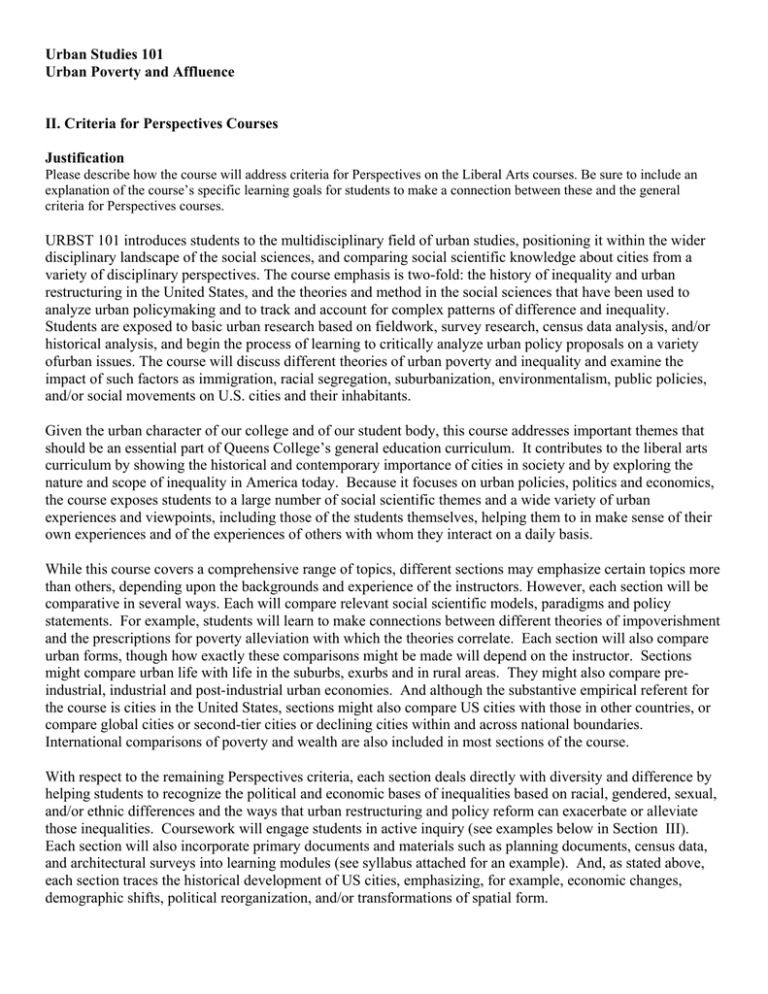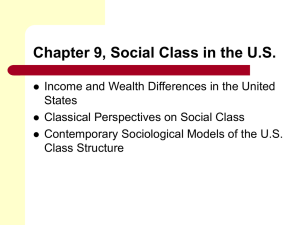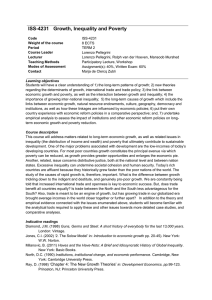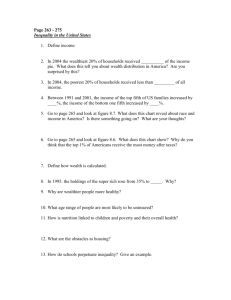Urban Studies 101 Urban Poverty and Affluence II. Criteria for Perspectives Courses
advertisement

Urban Studies 101 Urban Poverty and Affluence II. Criteria for Perspectives Courses Justification Please describe how the course will address criteria for Perspectives on the Liberal Arts courses. Be sure to include an explanation of the course’s specific learning goals for students to make a connection between these and the general criteria for Perspectives courses. URBST 101 introduces students to the multidisciplinary field of urban studies, positioning it within the wider disciplinary landscape of the social sciences, and comparing social scientific knowledge about cities from a variety of disciplinary perspectives. The course emphasis is two-fold: the history of inequality and urban restructuring in the United States, and the theories and method in the social sciences that have been used to analyze urban policymaking and to track and account for complex patterns of difference and inequality. Students are exposed to basic urban research based on fieldwork, survey research, census data analysis, and/or historical analysis, and begin the process of learning to critically analyze urban policy proposals on a variety ofurban issues. The course will discuss different theories of urban poverty and inequality and examine the impact of such factors as immigration, racial segregation, suburbanization, environmentalism, public policies, and/or social movements on U.S. cities and their inhabitants. Given the urban character of our college and of our student body, this course addresses important themes that should be an essential part of Queens College’s general education curriculum. It contributes to the liberal arts curriculum by showing the historical and contemporary importance of cities in society and by exploring the nature and scope of inequality in America today. Because it focuses on urban policies, politics and economics, the course exposes students to a large number of social scientific themes and a wide variety of urban experiences and viewpoints, including those of the students themselves, helping them to in make sense of their own experiences and of the experiences of others with whom they interact on a daily basis. While this course covers a comprehensive range of topics, different sections may emphasize certain topics more than others, depending upon the backgrounds and experience of the instructors. However, each section will be comparative in several ways. Each will compare relevant social scientific models, paradigms and policy statements. For example, students will learn to make connections between different theories of impoverishment and the prescriptions for poverty alleviation with which the theories correlate. Each section will also compare urban forms, though how exactly these comparisons might be made will depend on the instructor. Sections might compare urban life with life in the suburbs, exurbs and in rural areas. They might also compare preindustrial, industrial and post-industrial urban economies. And although the substantive empirical referent for the course is cities in the United States, sections might also compare US cities with those in other countries, or compare global cities or second-tier cities or declining cities within and across national boundaries. International comparisons of poverty and wealth are also included in most sections of the course. With respect to the remaining Perspectives criteria, each section deals directly with diversity and difference by helping students to recognize the political and economic bases of inequalities based on racial, gendered, sexual, and/or ethnic differences and the ways that urban restructuring and policy reform can exacerbate or alleviate those inequalities. Coursework will engage students in active inquiry (see examples below in Section III). Each section will also incorporate primary documents and materials such as planning documents, census data, and architectural surveys into learning modules (see syllabus attached for an example). And, as stated above, each section traces the historical development of US cities, emphasizing, for example, economic changes, demographic shifts, political reorganization, and/or transformations of spatial form. The course fulfills the criteria for the Analyzing Social Structures (SS) Area of Knowledge and Inquiry. From a variety of disciplinary perspectives, and with careful attention directed at the problems, limitations and ongoing need to rethink various research paradigms, each section addresses the structural and institutional forces that shape how cities work and that produce and reproduce different patterns of inequality. The course also emphasizes the United States (US) Context of Experience. Recognizing that cities have played an important role in shaping American political and cultural history, and that they have been important yet contradictory sites of civic engagement and democratic practice, URBST 101 addresses the role of migration in US society, its changing racial, ethnic, religious, and linguistic diversity, and contests over inclusion and exclusion from the unique vantage point of its urban residents. Please note that URBST 101 as it is currently taught fulfills most of the Perspectives criteria. It fulfills Area of Knowledge and Context of Experience criteria, is comparative in approach, focuses on structural forces, and considers diversity and forms of difference. Yet this proposal also reflects important changes designed to make URBST 101 more effective as part of the new general education curriculum. The following criteria, previously recommended but not required for each section, will now be required: 1) An overview of the field of urban studies within the wider social science context; 2) A discussion of the historical development of US cities; 3) The incorporation of primary texts; 4) Assignments and/or classroom exercises emphasizing active inquiry. Criteria Checklist Please be sure that your justification addresses all three criteria 1-3, below. For criteria 4-8, please check all that apply and discuss these in your justification. A Perspectives course must: 1. Be designed to introduce students to how a particular discipline creates knowledge and understanding. 2. Position the discipline(s) within the liberal arts and the larger society. In addition, a Perspectives course will, where appropriate to its discipline(s) and subject matter: 4. Be global or comparative in approach. 5. Consider diversity and the nature and construction of forms of difference. 6. Engage students in active inquiry. 3. Address the goals defined for the particular Area(s) of Knowledge the course is designed to fulfill. 7. Reveal the existence and importance of change over time. 8. Use primary documents and materials. III. Course Materials, Assignments, and Activities Please provide an annotated list of course readings and descriptions of major assignments or exams for the course, as well as distinctive student activities that will engage students in working toward the course goals discussed in the course description and/or justification. Please include the author and title for each reading or text, along with a short description providing information about how the reading will contribute to course goals. Course Materials: A broad range of course material is appropriate for this course. The texts described below exemplify the kinds of material that could be used to meet course objectives. This is hardly an exhaustive list. John J. Macionis and Vincent N. Parrillo. 2006. "The Development of North American Cities." In Cities and Urban Life. Upper Saddle River, N.J.: Prentice Hall, pp. 62-104. This chapter will be used to help students learn about the historical development of US cities and to compare different urban forms. It describes the history of US and Canadian cities from the pre-industrial period to the industrial period, to the post-industrial period. It describes important changes in urban economy as cities shifted their economic focus from trade to manufacturing to service delivery. It also includes descriptions of the political, demographic and spatial organization of cities during different historical epochs and contains a brief synopsis of New York City’s historical development from a Dutch colony to the global financial center that it is today. Excerpts from texts, such as Sassen’s The Global City, Harvey’s The Urban Experience, or Logan and Molotch’s The Growth Machine may also be appropriate for establishing the historical and comparative basis of knowledge about cities. Goldsmith and Blakely. 1992. Chapter 1. In Separate Societies: Poverty and Inequality in US Cities. Philadelphia, PA: Temple University Press, pp. 1-14. This chapter will help students to gain familiarity with contemporary approaches to the study of poverty and inequality from a variety of social scientific perspectives and disciplines. Written by two sociologists, it compares three theories of impoverishment: poverty as pathology, poverty as accident and poverty as structure. It explains the political and policy prescriptions that typically align themselves with each theory. Additional texts such as Wilson’s The Truly Disadvantaged (sociology), Maskovsky and Goode’s The New Poverty Studies (Anthropology), Piven and Cloward’s Regulating the Poor (Political Science), Alice O’Conner’s Poverty Knowledge (History), and Michael Katz’ The Undeserving Poor (History), among other texts, may also be appropriate for introducing students to different paradigms for studying urban poverty. Laura Maggi, “The Poor Count,” American Prospect (Nov. 30, 2002). This article will be used to describe how poverty and income inequality are calculated and tracked. It describes the formula used by the US government to establish the poverty line, and explains why this formula may not be accurate in determining who is actually living in poverty. The Economist. 2004. “Meritocracy in America: Ever higher society, ever harder to ascend.” In The Economist (Dec 29th 2004). This piece summarizes several multi-generational studies on class mobility, explaining the chances for upward mobility for people on different rungs of the US income ladder. It will be used to shatter the myth of upward mobility. Devah Pager and Bruce Western. 2005. “Race at Work” A paper published by the Schomburg Center for Research in Black Culture (December 9, 2005). This audit, conducted by sociologists, shows the effects of racial discrimination at the bottom end of the NYC labor market. It will be used to show the contribution of audit studies to the analysis of labor market participation. Massey and Denton. 1993. American Apartheid: Segregation and the Making of the Underclass. Cambridge, MA: Harvard University Press. A classic in the field of sociology, this book summarizes the findings in several qualitative studies to test the validity of various theories of residential segregation. It will be used to show the contribution of audits and survey research to the study of racial inequality. Gregory Pappas. 1989. The Magic City. Ithaca, New York : Cornell University Press. This is an ethnographic account of the effects of deindustrialization on a factory town and its inhabitants. It will be used to show the contribution of ethnography to the study of poverty. Peter Eisinger. 2000. “The Politics of Bread and Circuses” Urban Affairs Review, Vol. 35, No. 3, 316-333 (2000) This is a critique of large-scale urban development plans involving city-subsidized stadium construction. It is but one example of the kinds of texts that can be read alongside NYC planning documents to help students to gain critical insights into the urban planning process. Major Assignments In addition to exams, course assignments will be designed to emphasize active learning among the students. Here are some sample assignments: 1) Students must pretend that they are a Republican Senator, a Democratic City Council member, and a welfare rights activist. They must write a paragraph explaining their view of urban poverty from each of these perspectives. They must describe why they think that some urban residents are poor, and tell us what should be done about urban poverty, from their conservative, liberal and left points of view. 2) Students must imagine that they are urban planners who must decide the fate of New York City. They must write a paragraph in support of each of the following economic development plans. 1) The City as an Entertainment Venue. New York, like other cities, has fallen on hard times. We are receiving only a fraction of the funding from the federal government that we once received. Affluent residents and businesses are leaving the city in droves. The city tax base is seriously eroded. We have no choice but to devote all of our political and fiscal resources to support entertainment facilities. Explain how this plan will help the city’s economy. Explain how different groups – politicians, developers, residents, small- business owners – will benefit from this plan. Explain what sacrifices must be made to develop the city as an entertainment venue and who will have to make them. 2) The City to Accommodate Residential Interest. New York, like other cities, has indeed fallen on hard times. We must devote all possible resources to maintaining the city’s infrastructure and to providing services and resources to our residential neighborhoods. Explain the effect that big development projects have for the city and how you would establish a balanced set of urban priorities. Explain how this plan will help the city’s economy. Explain how different groups – politicians, developers, residents, small- business owners – will benefit from this plan. Explain what sacrifices must be made to develop the city for its residents and who will have to make them. 3) Students are asked to pretend that they are reporters or photojournalists. Their editors have given them the assignment to write a short, two to three paragraph article about the militarization of public space in New York City. In the article, the student should document this phenomenon in journalistic fashion. They must pick a building, park, street corner, etc. that they think best exemplifies the militarization of public space in New York and describe it in detail for the readership. They must explain to their readers how architectural design, surveillance technology and policing discourage people from gaining free, unfettered access to what could be public places. Exams: Exams will be comprised of multiple choice, short answer and essay questions. The purpose of exams will not be to ask students to memorize facts in isolation. Rather, it will be to help them to synthesize course material. Examples of exam questions include: 1) A. Multiple Choice (2 points each): Transnationalism A. Moving to one country but maintaining extensive ties to your home country. B. Moving to one country and cutting off all ties to your home country. C. Living on the East Coast while frequently visiting the West Coast. D. Inviting people from other countries to be your friend on a social networking site. B. Model minority myth A. A seldom-told tale about how models created the world. B. Idea that certain minorities get ahead because they are disciplined and have strong family ties. C. Idea that certain minorities get ahead because they make the best models. D. None of the above. 2) Why are people of color under-represented in New York City electoral politics? Does individual voting behavior account for lower registration and turnout in people of color assembly districts? If not, what are the alternative explanations? (10 pts) 3) Urban restructuring since WWII has caused an increase in political and economic inequality in major metropolitan areas such as New York. Describe how changes in employment policies and practices, the persistence of segregation, immigration policies, the militarization of public space, the advent of new development policies, and shifts in social policy such as welfare “reform” have created new patterns of inequality in many urban areas. Discuss the consequences of these developments for the urban poor. You must provide concrete, detailed examples from course materials. (30 pts) IV. Assessment Perspectives courses must be recertified every five years, and we are seeking ideas for how to best carry out this assessment. What forms of evidence that the course is meeting its goals as a Perspectives course would be appropriate to collect for this course during the next five years? How would you prefer assessment to be conducted? How might evidence of effective teaching and student learning be collected and evaluated? Syllabi will be collected and reviewed periodically to assess the extent to which they continue to meet the criteria for Perspectives courses. We willcollect this information and periodically submit a short report to the GEAC. Obviously there should be no punitive measures attached to the collection of this information or the evaluation protocol might be compromised. The Urban Studies Department has established for itself a comprehensive outcomes assessment protocol designed to collect and evaluate a wide variety of evidence of effective teaching and student learning. It will not be difficult to assess the extent to which this course is meeting the respective goals as part of our wider evaluation activities. However, there are important questions about Perspectives courses that might be best answered through a college-wide assessment of the new general education curriculum. One big and important question is whether the goals of this new general education curriculum are more transparent to the students than are the goals of LASAR. Another is whether or not the quality of general education is improving on campus. It would make sense for the college to establish an assessment committee sooner rather than later if it hopes to collect evidence about these questions, since it will be very much beyond the purview of individual departments to collect relevant and comparable data unless asked to do so well in advance and in clear and concise ways. V. Administration What process will your department develop to oversee this course, suggest and approve changes, and conduct assessment? Who will be in charge of this process? Also indicate whether the course will be primarily taught by full-time or adjunct faculty, or by a combination of the two types of instructor. URBST 101 is primarily taught by a combination of full-time and adjunct faculty, who meet regularly to go over course material and syllabi. Jeff Maskovsky, chair of the department’s Undergraduate Curriculum Committee schedules and chairs these meetings. Urban Studies’ Undergraduate Curriculum Committee will oversee all administrative matters and evaluation protocols for our Perspective courses. In addition to standard evaluation protocols, which include regular observations of all instructors and reviews of all syllabi, the committee will incorporate an evaluation of our Perspectives courses into our ongoing outcomes assessment protocol. We will devise several means – pre- and post-testing, the analysis of student portfolios, and so forth – to determine the extent to which our new Gen. Ed. courses are effectively taught and our students are reaching their general education learning objectives. Our curriculum committee is comprised of Jeff Maskovsky, Tarry Hum, Alice Sardell, Len Rodberg, Dana-Ain Davis, Melissa Checker and Madhulikah Khandelwal.







